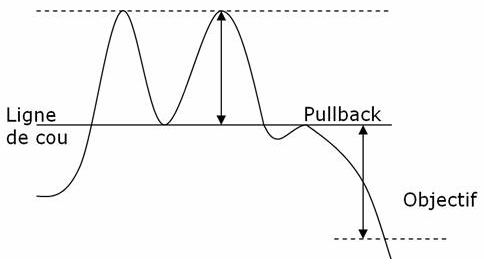The double top is a bearish pattern shaped like an M. Two tops must succeed, imaging an important resistance. This marks a reversal. The pattern may also be in WV shape. We can consider a triple top as well.
The initial correction will decide how the neckline is evidenced by the lowest between the two tops. Consequently, the price will return to the resistance. The degree of the two or three tops will normally be the same (as our example below shows), however it may happen that the first top will be higher than the first one. This configuration will reinforce the validity of the figure since it will reflect a breathlessness of the buying movement. A third rebound could happen, but in all cases, it is the breaking of the neckline that should validate the bearish reversal.

Once the neckline is broken, it could happen that the price will get back to it (this line becomes the resistance), then will decrease again. The potential of this decrease is determined by the difference among the beginning resistance and of the neckline.
Following are several statistics about the double top:
– In 75% of cases, there will be a bearish reversal.
– In 71% of cases, the target of the pattern is reached once the neckline is broken.
– In 61% of cases, a pullback will occur.
– In 83% of cases, there is a pursuit of that movement once the neckline is broken.
In case of pullback, the upward movement will be less important once the target of the pattern is reached.
When more the two bottoms are closed, the more the percentage of success of the pattern is important.
The more the bullish movement that precedes the formation of the double top is important, the more the downward movement at the breakout of the neckline will be powerful.
